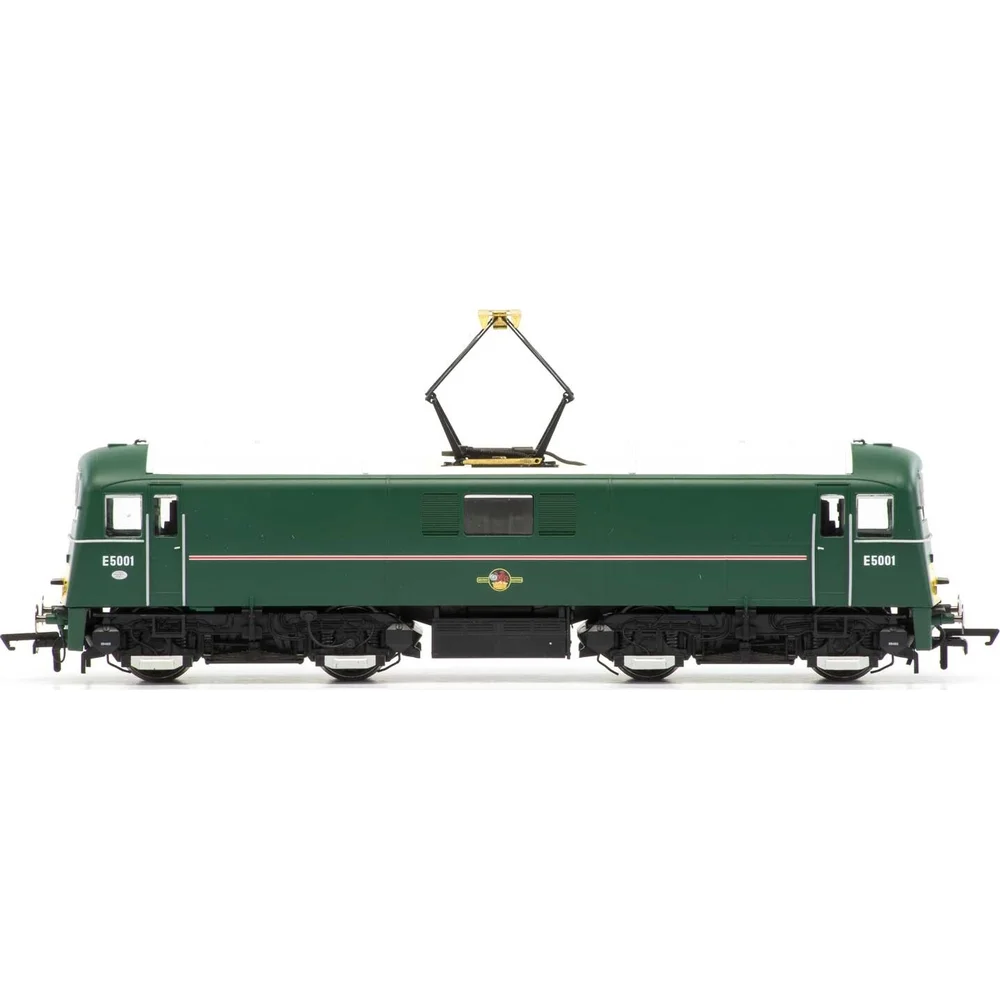Hornby R3373
British Rail Class 71 E5001 British Railways Green with Small Yellow Panels
Tooling
Hornby announced its all-new tooling for the British Rail Class 71 electric locomotive at the Warley National Model Railway Exhibition in late 2014, with models entering production in 2016. The Class 71 was a Southern Region Bo-Bo electric locomotive built between 1958 and 1960 for mixed-traffic duties on third-rail electrified routes. Hornby’s model was developed using 3D laser scanning of the preserved locomotive E5001 at Barrow Hill, ensuring high fidelity to the prototype. This release marked Hornby’s first detailed rendition of the type, competing directly with DJ Models in the same period.
Tooling Features
- Body Construction: Plastic bodyshell with separately fitted details; die-cast chassis for strength and weight
- Detailing: Factory-fitted handrails, cab footsteps, etched side grilles, bufferbeam detail, pipework, speedometer cable, and 3rd rail pick-up shoe. Sprung buffers and flush glazing included. Cab interiors are painted and detailed with seating and controls.
- Pantograph: Cross-arm type, poseable but unpowered
- Couplings: NEM pockets with tension-lock couplers
Mechanical & Electrical Specification
- Motor: 5-pole skew-wound motor with twin flywheels for smooth running
- Drive: All-wheel drive and all-wheel electrical pickup
- Lighting: Directional head and tail lights, plus cab lighting
- Weighting: Integrated within the die-cast chassis for improved adhesion
DCC Capability
- DCC Ready with 8-pin socket
- Provision for a 15x11 mm rectangular speaker for sound installation
Liveries Produced
Hornby released several versions under this tooling, including:
- BR Green with late crest (with and without yellow warning panels)
- BR Blue with full yellow ends
- Special editions such as Pullman train packs
Reviews & Commentary
The Hornby Class 71 received positive feedback for its accuracy and fine detailing, particularly the etched grilles and cab interiors. Reviewers praised its smooth running and lighting features, though some noted that the pantograph was cosmetic only. Comparisons with DJ Models highlighted Hornby’s strong finish and reliable mechanism. Social media and forums welcomed the model as a long-awaited addition for Southern Region layouts, with particular interest in its representation of iconic services like the Golden Arrow and Night Ferry.
Interesting Notes
- The model was developed using LIDAR scanning of the preserved E5001 locomotive.
- Hornby included alternative headcodes and detailing parts in the accessory pack for customization.
Class & Prototype
- Class: British Rail Class 71
- Traction: Electric
- Built: 1958-1960
- Total Built: 24
No prototype found.
Operator & Livery
- Operator: British Railways
- Livery: Green with Small Yellow Panels
British Railways transformed Britain's fragmented rail network into a unified national system following nationalisation on 1st January 1948. Created from the "Big Four" companies under the Transport Act 1947, BR operated most of Great Britain's railways until rebranding as British Rail in 1965, managing over 20,000 route miles and inheriting nearly 20,000 locomotives of diverse designs.
The organisation pioneered standardisation through its revolutionary BR Standard locomotive programme (1951-1960), producing 999 advanced steam engines under Robert Riddles' direction. These included the versatile Britannia Pacifics, mighty 9F freight engines, and mixed-traffic classes that incorporated the best features from all predecessor companies. The 1955 Modernisation Plan accelerated diesel and electric traction development, creating fascinating mixed-traction operations.
Notable achievements included establishing unified locomotive classification systems, introducing distinctive corporate liveries, and managing the complex transition from steam to modern traction. BR's six regional structure preserved operational diversity whilst enabling standardisation of practices, signalling, and rolling stock that had eluded private enterprise for over a century.
The BR era represents steam traction's final flowering alongside emerging diesel technology, creating unparalleled locomotive variety. Today, this heritage remains highly popular with railway enthusiasts through extensive preserved fleets, heritage railway operations, and comprehensive model ranges from manufacturers like Hornby, Bachmann, and Dapol, making BR subjects essential for authentic post-war British railway modelling across all scales.
British Railways' green livery with small yellow warning panels represented a significant safety evolution during the early 1960s, combining the established prestige of the Deep Bronze Green finish with new visibility requirements for locomotive operations. The basic livery remained the standard BS224 Deep Bronze Green used on express passenger steam locomotives, maintaining visual continuity across the modernising fleet whilst incorporating practical safety improvements mandated by changing operational practices.
The distinctive feature of this livery was the addition of small yellow warning panels to the lower portion of locomotive ends, initially introduced around 1960-1962 as BR began implementing enhanced visibility measures. These panels were typically rectangular and covered only the lower section of each cab front, leaving the majority of the end in the base green colour. Many locomotives in this livery also featured additional decorative elements including grey roofs, white cab window surrounds, and various stripe configurations - some had broad horizontal grey or light-coloured stripes at solebar level, whilst others featured narrow white stripes positioned at waist height along the bodysides.
This livery variant appeared across numerous diesel classes including the Class 24, 26, 27, 35 (Hymek), 46, and others during the early-to-mid 1960s transition period. The small yellow panels were later expanded to full yellow ends from around 1966-1967, making the intermediate period with partial yellow treatment relatively brief but historically significant. Locomotives carried either the early "Lion and Wheel" or later "Lion and Crown" crests depending on their painting date, positioned centrally on the bodysides. This livery represents BR's cautious approach to safety modernisation, gradually introducing visibility improvements whilst maintaining traditional railway aesthetics before the comprehensive Rail Blue revolution transformed the entire fleet's appearance from 1965 onwards.
